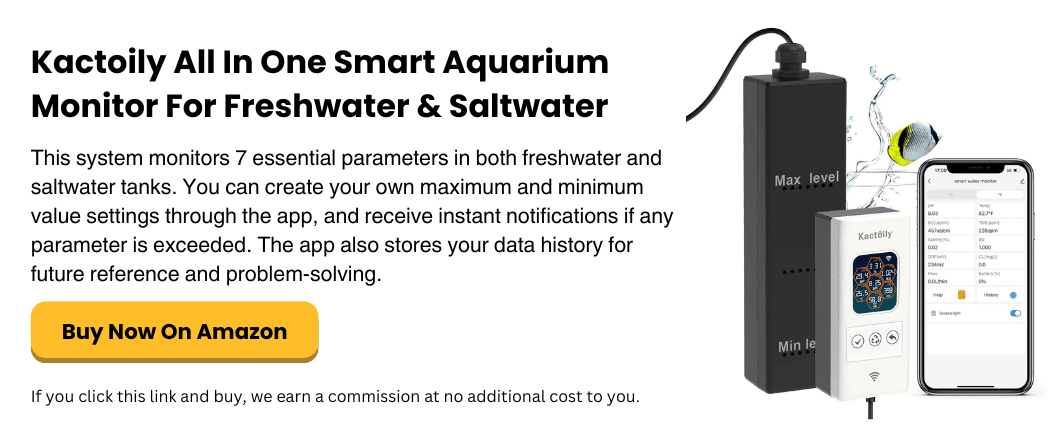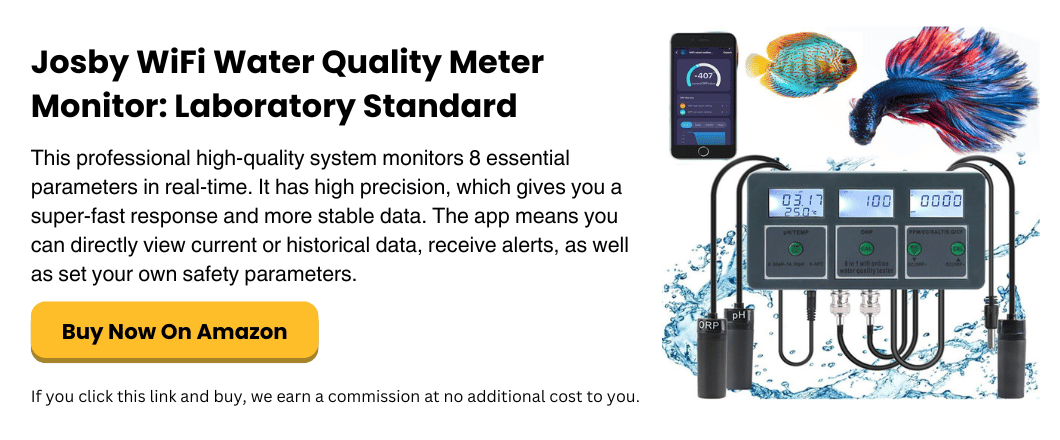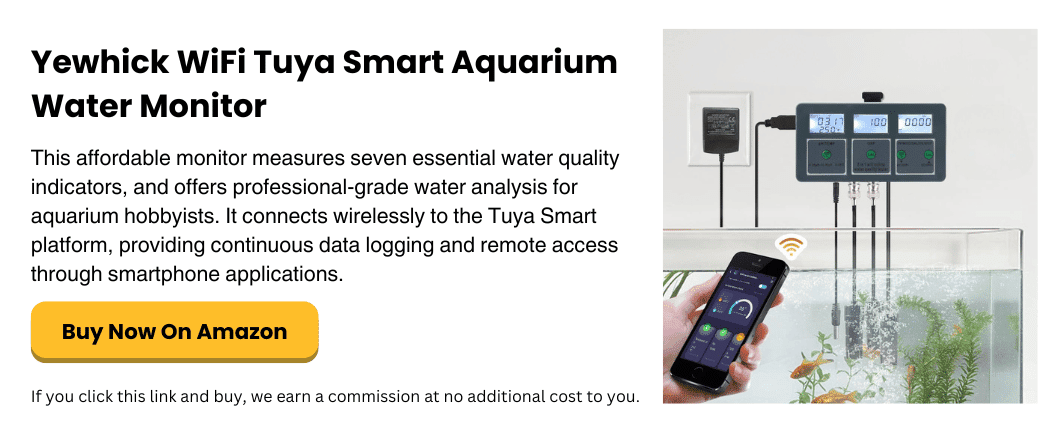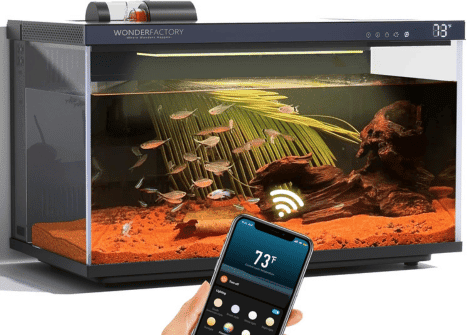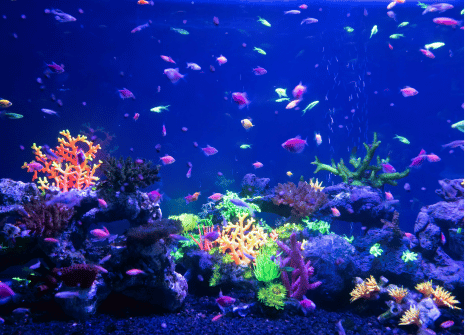A Guide To Smart Aquarium Water Monitors
If you’re like most aquarium enthusiasts, you’ve probably spent countless hours testing water parameters, wondering if everything’s just right for your fish and plants.
While keeping your water quality perfect is absolutely essential for a thriving tank, let’s be honest – all that manual testing can feel overwhelming, especially when you’re trying to balance it with work, family, and everything else life throws your way. That’s where smart aquarium water monitors come in as real game-changers.
These clever devices continuously watch over your tank, sending updates straight to your phone and taking all the guesswork out of water management, so you can spend more time enjoying your aquatic friends and less time worrying about them.
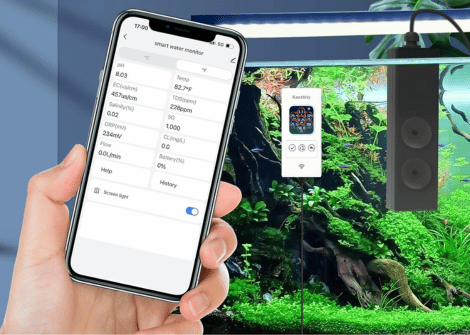
Table of Contents
Understanding Smart Aquarium Water Monitors
Key Parameters Monitored
Benefits Of Smart Water Monitoring
Types Of Smart Water Monitors
Installation And Setup Considerations
Maintenance And Care
Choosing The Right Smart Aquarium Monitor
The Best Smart Aquarium Monitors
Final Thoughts
Understanding Smart Aquarium Water Monitors
Smart aquarium water monitors represent a significant leap forward in aquatic technology.
These sophisticated devices continuously track multiple water parameters simultaneously, transmitting data wirelessly to your smartphone, tablet, or computer.
Unlike traditional test kits that provide snapshots of water conditions at specific moments, smart monitors deliver continuous monitoring, creating detailed trends and patterns that reveal the true health of your aquatic ecosystem.
The core technology behind these devices typically involves multiple sensors housed in a waterproof unit that either floats in your tank or mounts externally with probe extensions.
Advanced models incorporate artificial intelligence algorithms that learn your specific tank’s patterns and can predict potential problems before they become critical issues.
Modern smart monitors go far beyond simple parameter tracking. They integrate with broader home automation systems, connect to cloud-based databases for comparative analysis, and often include community features that allow you to share data with other aquarists or consult with experts remotely.
Smart systems monitor a range of vital parameters which are essential for the health and sustainability of your aquarium.
Temperature stability is fundamental to aquatic health, and smart monitors excel at tracking thermal fluctuations that manual thermometers might miss.
These devices record temperature variations throughout day and night cycles, helping you identify heating system malfunctions, seasonal impacts, or equipment failures before they stress your aquatic inhabitants.
Advanced temperature monitoring includes features like thermal trend analysis, which can predict when your heater might be failing based on performance patterns. Some systems even differentiate between surface and deeper water temperatures, crucial for larger tanks where thermal stratification can occur.
pH monitoring through smart systems provides unprecedented precision in tracking this critical parameter.
Rather than relying on color-change strips or liquid reagents, digital pH sensors offer exact numerical readings with decimal precision. Continuous monitoring reveals pH swings that occur naturally throughout light cycles, helping you understand your tank’s unique chemistry patterns.
Smart pH monitoring becomes particularly valuable in planted tanks, where photosynthesis creates natural pH fluctuations, or in marine systems where calcium reactors and protein skimmers can impact pH levels throughout the day.
Oxygen levels fluctuate significantly in aquarium environments, influenced by temperature, lighting, plant activity, and fish bioload. Smart monitors track these variations continuously, alerting you to dangerous drops that could stress or harm your aquatic life.
This monitoring proves especially critical during hot weather when warm water holds less dissolved oxygen, or in heavily planted tanks where nighttime respiration can dramatically reduce oxygen levels.
Electrical conductivity measurements provide insights into overall water quality and mineral content.
Smart monitors track conductivity changes that indicate evaporation effects, filtration efficiency, or the need for water changes. This parameter is particularly valuable for brackish water setups or when maintaining specific mineral levels for sensitive species.
The nitrogen cycle forms the foundation of aquarium chemistry, and smart monitors equipped with these sensors provide early warning systems for dangerous spikes.
Real-time ammonia detection can alert you to overfeeding, filter malfunctions, or biological overload before these conditions become life-threatening.
Nitrate tracking helps optimize water change schedules and feeding regimens, while nitrite monitoring ensures your biological filtration remains effective.
Benefits of Smart Water Monitoring
So what benefits does a smart water monitoring system give you?
The immediate notification capability of smart monitors represents their greatest advantage over traditional testing methods.
Whether you’re at work, traveling, or simply sleeping, these systems can alert you via smartphone notifications when parameters drift outside acceptable ranges.
Customizable alert thresholds allow you to set different warning levels based on your specific livestock requirements. Emergency alerts can be configured for life-threatening conditions, while trend alerts notify you of gradual changes that require attention but aren’t immediately dangerous.
Smart monitors create comprehensive databases of your tank’s water quality history, enabling you to identify patterns, seasonal variations, and the effectiveness of different management approaches.
This historical data proves invaluable for troubleshooting problems, optimizing care routines, and documenting successful breeding conditions.
Long-term data analysis can reveal subtle correlations between water parameters and fish behavior, plant growth, or coral health that would be impossible to detect through manual testing.
Modern aquarists often maintain multiple tanks or travel frequently, making remote monitoring essential. Smart systems allow you to check your tank’s status from anywhere with internet connectivity, providing peace of mind during vacations or business trips.
Remote monitoring extends beyond simple parameter checking – many systems allow remote equipment control, feeding schedule adjustments, and even consultation with aquarium maintenance services who can access your data to provide informed recommendations.
Smart water monitors integrate seamlessly with broader aquarium automation systems.
They can trigger automatic water changes when nitrates exceed target levels, adjust lighting schedules based on pH fluctuations, or activate backup aeration when oxygen levels drop.
This integration creates truly intelligent aquarium systems that respond automatically to changing conditions, reducing the manual intervention required for optimal water quality maintenance.
Types of Smart Water Monitors
Comprehensive monitoring systems incorporate multiple sensors into single units, providing complete water quality oversight from one device.
These systems typically monitor temperature, pH, dissolved oxygen, and conductivity simultaneously, with some advanced models adding nitrogen compound sensors.
All-in-one systems offer convenience and often prove more cost-effective than purchasing individual parameter monitors separately.
They typically feature unified smartphone apps that display all parameters on single dashboards with coordinated alert systems.
Specialized monitors focus on specific parameters, allowing aquarists to customize their monitoring setup based on their particular needs. This approach proves especially valuable for addressing specific challenges, such as pH stability in marine reef tanks or dissolved oxygen in heavily stocked systems.
Individual monitors often provide greater accuracy and more advanced features for their specific parameters compared to all-in-one systems, making them preferred choices for serious hobbyists or commercial applications.
Probe-based systems feature external control units with waterproof sensors that extend into the aquarium. This design allows for more sophisticated electronics while keeping sensitive components away from moisture. Probe systems often offer higher accuracy and longer sensor life.
Floating designs integrate all components into waterproof units that sit directly in the aquarium. While potentially more convenient, they may be limited in sensor sophistication due to size constraints and waterproofing requirements.
Installation and Setup Considerations
Whichever monitoring system you choose, there are a number of important factors you need to keep in mind when you go about installing and setting up the monitor:
Strategic sensor placement significantly impacts monitoring accuracy and reliability.
Temperature sensors should be positioned away from heaters and in areas with good water circulation to provide representative readings. pH probes require placement in well-mixed water areas while avoiding direct contact with substrate or decorations that might affect readings.
Multiple sensor placement becomes crucial in larger tanks where conditions may vary significantly between different areas. Understanding your tank’s water circulation patterns helps determine optimal monitoring locations.
Regular calibration ensures monitoring accuracy and represents the most critical maintenance requirement for smart water monitors.
Most systems require calibration using standard reference solutions, with calibration frequency varying by parameter type and usage intensity.
Establishing calibration schedules and maintaining calibration solution supplies prevents monitoring accuracy degradation. Some advanced systems feature automatic calibration reminders or even self-calibrating capabilities.
Smart monitors require reliable power sources and stable internet connectivity for optimal performance.
Battery-powered units offer installation flexibility but require regular battery replacement or charging. Wired systems provide consistent power but limit placement options.
Wi-Fi connectivity strength at your aquarium location affects data transmission reliability and smartphone app responsiveness. Some systems offer backup connectivity options or local data storage for situations when internet connectivity is intermittent.
Maintenance and Care
Like any aquarium equipment, your smart water monitor needs a little TLC to keep working accurately for years to come. Don’t worry though – there are only two main areas to keep in mind and they won’t take much time away from enjoying your tank.
Regular sensor maintenance ensures continued accuracy and extends equipment lifespan. Different sensor types require specific cleaning protocols – pH probes need specialized storage solutions, while conductivity sensors require periodic cleaning to remove mineral buildup.
Understanding replacement schedules for different sensor types helps budget for ongoing maintenance costs. Most sensors require replacement every 12-24 months depending on usage intensity and water conditions.
Smart monitoring systems regularly receive software updates that improve functionality, add features, or enhance security. Keeping systems updated ensures optimal performance and access to the latest capabilities.
Data management becomes important as systems accumulate extensive historical information. Understanding backup procedures and data export capabilities protects valuable tank history and enables advanced analysis using external software.
Choosing the Right Smart Water Monitor
With so many smart monitors on the market, picking the perfect one for your setup might feel a bit overwhelming at first. The good news is that by considering a few key factors about your specific tank and goals, you’ll quickly narrow down your options to find the ideal match.
Different aquarium types and inhabitants require different monitoring priorities.
Freshwater planted tanks benefit most from pH and CO2 monitoring, while marine reef systems require comprehensive calcium, alkalinity, and magnesium tracking. Understanding your specific requirements helps select appropriate monitoring capabilities.
Tank size, bioload, and automation level also influence monitor selection. Heavily stocked tanks benefit from comprehensive nitrogen compound monitoring, while automated systems require monitors that integrate well with existing equipment.
Smart water monitors range from basic temperature and pH units to comprehensive systems monitoring dozens of parameters. Balancing desired features with budget constraints requires understanding which parameters are most critical for your specific setup.
Consider ongoing costs including sensor replacements, calibration solutions, and potential subscription fees for cloud-based services when evaluating total ownership costs.
Ensuring compatibility with existing equipment and desired future upgrades prevents integration problems and maximizes system value. Some monitors work exclusively with specific brands of equipment, while others offer broad compatibility with various manufacturers.
Consider smartphone platform compatibility, home automation integration capabilities, and available third-party software options when making selection decisions.
The Best Smart Aquarium Water Monitors
Here are what we consider the 3 best smart aquarium water monitors for you to consider. We have chosen the Best Overall Monitor, Best Professional Monitor, and Best Budget Monitor:
Best Overall Smart Water Monitor
The Kactoily All In One Smart Aquarium Monitor continuously monitors seven critical parameters including pH, ORP, salinity, specific gravity, TDS, electrical conductivity, and temperature in both freshwater and saltwater aquariums. It provides laboratory-standard results, as well as 24-hour online monitoring with real-time data accessible through the smartphone app.
Best Professional Smart Water Monitor
The Tapo TP-Link 2K QHD Camera is a versatile surveillance camera that is proving popular with reptile owners. It has 2K quad-high-definition recording with advanced AI detection capabilities, as well as color night vision and invisible infrared modes. It’s also built to withstand extreme heavy rain as powerful as high-pressure water jets!
Pros:
-
Comprehensive 8-Parameter Testing – Simultaneously measures pH, electrical conductivity, total dissolved solids, salinity, specific gravity, conductivity factor, oxidation-reduction potential, and temperature in a single device.
-
Professional-Grade Accuracy – Digital sensors provide laboratory-quality measurements with precise readings that rival expensive commercial testing equipment, ensuring reliable data for critical applications.
-
Real-Time WiFi Connectivity – Wireless connection enables continuous monitoring and instant alerts when water parameters drift outside safe ranges, preventing costly fish losses or plant damage before problems escalate.
-
Intuitive Smartphone App Integration – Tuya Smart platform offers user-friendly mobile control with historical data tracking, customizable alerts, and trend analysis for informed decision-making about water management.
-
Multi-Application Versatility – Suitable for freshwater and saltwater aquariums, and other water quality monitoring needs, making it valuable for various hobbyists and professionals.
-
Automated Data Logging – Continuous recording and cloud storage of measurements creates detailed historical records for identifying patterns, troubleshooting issues, and maintaining optimal conditions over time.
-
Cost-Effective Monitoring Solution – Replaces multiple individual testing devices and eliminates ongoing costs of test strips or liquid reagents, providing long-term savings for serious water quality management.
-
Remote Accessibility – Monitor water conditions from anywhere with internet access, perfect for vacation monitoring, commercial facilities, or managing multiple systems from a central location.
Cons:
-
Calibration Maintenance Requirements – Digital sensors need periodic calibration with standard solutions to maintain accuracy, requiring ongoing maintenance and calibration fluid purchases for optimal performance.
-
Learning Curve for Advanced Features – Multiple parameters and app settings may overwhelm beginners, requiring time investment to understand optimal ranges and alert configurations for specific applications.
Best Budget Smart Water Monitor
The Yewhick WiFi Tuya Smart Water Monitor Data Logger measures seven essential water quality indicators, including pH, temperature, TDS, salinity, specific gravity, electrical conductivity, and oxidation-reduction potential. It connects wirelessly to the Tuya Smart platform, providing continuous data logging and remote access through smartphone applications. Although it is an affordable model, designed for aquarium hobbyists, it offers professional-grade water analysis and automated monitoring capabilities.
Final Thoughts
Smart aquarium water monitors represent transformative technology that elevates aquarium keeping from reactive maintenance to proactive management. These sophisticated systems provide unprecedented insights into aquatic environments while reducing the time and effort required to maintain optimal conditions.
Whether you’re maintaining a simple freshwater community tank or managing a complex reef ecosystem, smart water monitors offer capabilities that traditional testing methods simply cannot match. The investment in smart monitoring technology pays dividends in improved livestock health, reduced maintenance stress, and greater enjoyment of your aquatic hobby.
More Reading
Using smart tech with your aquarium can make your life easier, and makes owning fish a lot more enjoyable. Our guide shows you what smart tech is, how it can help you, and if you really do need it.
Cloudy water in your aquarium can be a real problem – one that keeps coming back if you don’t resolve it properly. Learn what’s causing the cloudy water, how to clear it – and how to keep it permanently clean.
Smart lighting systems are a great addition to any fish tank, offering programmable sunrise-sunset cycles, and customizable color spectrums, They also promote natural fish behavior and reduce algae buildup.

